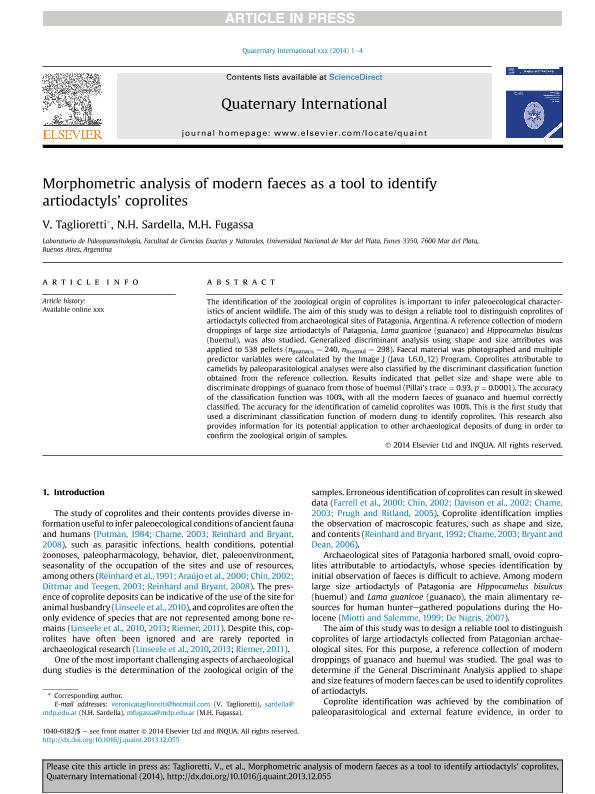Artículo
Morphometric analysis of modern faeces as a tool to identify artiodactyls' coprolites
Fecha de publicación:
11/2014
Editorial:
Pergamon-Elsevier Science Ltd
Revista:
Quaternary International
ISSN:
1040-6182
Idioma:
Inglés
Tipo de recurso:
Artículo publicado
Clasificación temática:
Resumen
The identification of the zoological origin of coprolites is important to infer paleoecological characteristics of ancient wildlife. The aim of this study was to design a reliable tool to distinguish coprolites of artiodactyls collected from archaeological sites of Patagonia, Argentina. A reference collection of modern droppings of large size artiodactyls of Patagonia, Lama guanicoe (guanaco) and Hippocamelus bisulcus (huemul), was also studied. Generalized discriminant analysis using shape and size attributes was applied to 538 pellets (nguanaco = 240, nhuemul = 298). Faecal material was photographed and multiple predictor variables were calculated by the Image J (Java 1.6.0_12) Program. Coprolites attributable to camelids by paleoparasitological analyses were also classified by the discriminant classification function obtained from the reference collection. Results indicated that pellet size and shape were able to discriminate droppings of guanaco from those of huemul (Pillai's trace = 0.93, p = 0.0001). The accuracy of the classification function was 100%, with all the modern faeces of guanaco and huemul correctly classified. The accuracy for the identification of camelid coprolites was 100%. This is the first study that used a discriminant classification function of modern dung to identify coprolites. This research also provides information for its potential application to other archaeological deposits of dung in order to confirm the zoological origin of samples.
Palabras clave:
Coprolite
,
Identification
,
Artiodactyls
,
Patagonia
Archivos asociados
Licencia
Identificadores
Colecciones
Articulos(CCT - MAR DEL PLATA)
Articulos de CTRO.CIENTIFICO TECNOL.CONICET - MAR DEL PLATA
Articulos de CTRO.CIENTIFICO TECNOL.CONICET - MAR DEL PLATA
Citación
Taglioretti, Verónica; Sardella, Norma Haydee; Fugassa, Martín Horacio; Morphometric analysis of modern faeces as a tool to identify artiodactyls' coprolites; Pergamon-Elsevier Science Ltd; Quaternary International; 352; 11-2014; 64-67
Compartir
Altmétricas




